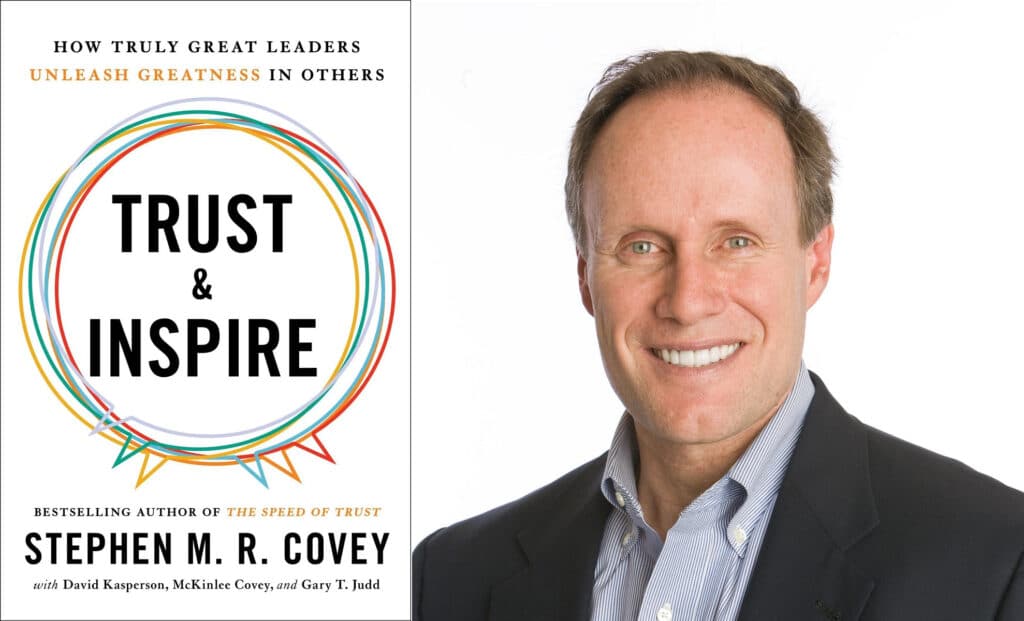Do you believe that most people are basically good, want to do the right thing, and have inherent talents? Good leaders have that mindset. They believe in the inherent capabilities of people.
“I bring you the gift of these four words: I believe in you.”
-Blaise Pascal, French mathematician, physicist, inventor, philosopher, and writer
Or do you believe most people are lazy or out for themselves? Unfortunately, some bosses have that mindset.
Lacking Faith in People
Some leaders have a negative mindset about people. That mindset may have been instilled by their parents, teachers, peers, or poor bosses. They view most people as selfish or lazy. They believe people need to be told what to do, rewarded for compliance, and punished for noncompliance.
Often, these bosses see others as stepping stones for their own goals. They’re wrapped up in their own egos and agendas.
These bosses generally don’t trust people and frequently micromanage them. They’re miserable to work for and are the main reason their direct reports either operate well below their potential or just give up and leave. These bosses can become toxic.

Leadership Derailers Assessment
Take this assessment to identify what’s inhibiting your leadership effectiveness. It will help you develop self-awareness and identify ways to improve your leadership.
Believing in People
Good leaders have a positive mindset about people. They realize that everyone has strengths and weaknesses. In some cases, a person’s natural talents are modest, but even then those talents can be significant when developed over time and leveraged.
Good leaders believe in people even while realizing that not everyone can be trusted and relied upon. Stephen M. R. Covey advocates “smart trust” in his influential book of the same name. The idea is to maximize the benefits of trusting while minimizing its risks. Covey notes that high-performance organizations have a culture of smart trust.
Good leaders go first in extending trust to newcomers and then adjust their level of trust based on how the newcomers behave. Leaders don’t extend total trust right away. That’s naïve. Nor do they mistrust newcomers, because that would be off-putting and demotivating. They extend a robust dose of smart trust.
“I prefer to give my trust a hundred times and risk being disappointed two or three times than to live perpetually in an atmosphere of distrust.” -Carl Freudenberg, founder, The Freudenberg Group
In his new book, Trust and Inspire: How Truly Great Leaders Unleash Greatness in Others, Stephen M. R. Covey writes that the first fundamental belief of what he calls a “trust and inspire leader” is this: “People have greatness inside them… so my job is to unleash their potential, not control them.”

Covey further explains the rationale as follows:
“If micromanaging people stifles their creativity and commitment to the work (and it does), trusting people does the opposite. When you extend trust, you’re telling people that you believe in them. You believe they’ll make rational decisions and good judgments. When given that level of belief and responsibility, people suddenly want to live up to it—they want to prove that trust justified. They go beyond their normal level of effort and tap into something deeper within, giving them access to greater energy, commitment, and, ultimately, results.” -Stephen M. R. Covey, Trust and Inspire
Good Leaders Show They Believe in People with Their Words & Actions
Good leaders believe in the capabilities of people and continually show that belief by their behavior. They extend smart trust. Also, they’re quick with recognition and praise and careful to offer feedback in private in most cases.
When recruiting people, good leaders look for “heart” qualities (integrity, emotional intelligence, courage, passion, authenticity, resilience, etc.) as well as “head” qualities (education, knowledge, skills, experience, etc.). When done well, this gives leaders even more reason to back their people confidently. They also co-create a shared purpose, values, and vison for their organization and inculcate it into the culture so that everyone is invested in those shared aims, further building trust and shared belief.
We’ve discovered that some of the most powerful things leaders can say to their colleagues are:
I believe in you.
I trust you.
I’ve got your back.
(See our article, “The Three Most Important Things Leaders Can Say to Their Teams.”)
When leaders back these words up with actions, it builds confidence in the team. It motivates people and helps unleash their talents. It facilitates mutual trust and shared commitment.
The Research on Leader Belief in People
In their book, The Leadership Challenge, James Kouzes and Barry Posner note that self-confidence affects performance—and that building people’s belief in themselves can help bolster their inner strength to move forward amidst uncertainty, make tough choices, and face opposition. We’d add that a great way to help people believe in themselves more is to show them that you believe in them. Kouzes and Posner also note that it’s a virtuous circle: believing in people causes leaders to be more positive in their actions, producing better results, reinforcing everyone’s belief that people can do great things.
“Expect the best. Belief in people’s abilities is essential to making extraordinary things happen. Exemplary leaders elicit high performance because they firmly believe in the abilities of their constituents to achieve even the most challenging goals…. Believing in others is an extraordinarily powerful force in propelling great performance.”
-James Kouzes and Barry Posner, The Leadership Challenge
In several studies, researchers demonstrated that leaders who began feedback with the following statement, “I’m giving you these comments because I have very high expectations, and I know that you can reach them,” had a greater effect on their recipients. The feedback was 40% more effective in subsequently changing relevant behaviors. (1)

Personal Values Exercise
Complete this exercise to identify your personal values. It will help you develop self-awareness, including clarity about what’s most important to you in life and work, and serve as a safe harbor for you to return to when things are tough.
Giving the Work Back to the People
Too many leaders not only fail to show people they believe in them, but they do the opposite. By micromanaging, leaders signal a lack of belief. That can lead to people being dependent on their leaders—and not able to do the adaptive work of figuring out how to proceed when things aren’t clear-cut.
One leadership framework helpful on this front comes from Ronald Heifetz and his associates, including Marty Linsky, at Harvard: adaptive leadership. One of the practices of adaptive leadership is giving the work back to the people. That means letting people decide what to do when they feel uncertain while expressing a belief in their ability to figure it out and encouraging them to take responsibility for it.
Different Dispositions to Work
Our experience is that people have widely varying dispositions to their work and organization. We can think of them as being on a spectrum. Some people are “all in” with their work. Others are outright resistant to it. Most people are somewhere in between, with some reservations.
Workers who are “all in” are highly motivated. They get what the leader is trying to do and swiftly get on board. They commit to the purpose, operate by the shared values, and readily accept new assignments to help accomplish the vision. It’s not difficult for leaders to show their belief in these workers. One challenge here is to avoid showing favoritism, as that can be highly demotivating for other workers.
Workers in the middle, who have some reservations, aren’t always sure of the motives of their managers. Perhaps they’ve been burned before by less skilled bosses. They wonder if a new direction is just a fad and if the leaders are credible and trustworthy.
Bob saw this often in his work as a turnaround CEO in troubled companies. During all-hands meetings, many workers sat listening with their arms crossed. They were skeptical and unsure whether and how much to trust and commit.
In our experience, many of these people can be persuaded over time that earnest efforts to create a new culture aren’t gimmicks. When they realize that there’s genuine effort, caring, and integrity—and belief in them—many will open up and commit. It’s a beautiful thing to behold. Witnessing their transformation from reserved to “all in” is one of the most rewarding things a leader can experience. It’s like seeing them come out of the darkness and into the light.
The outright resisters are a special case. For whatever reason, they’re checked out. Some may be saved with patience, attention, sincere listening to their issues, modest assignments that pull them back in, and stubborn belief in them. When that happens, it’s an incredible transformation. Such changes are life-changing for the people involved—and significant in changing the culture of the organization.
Sadly, though, some of these resisters can’t be brought back into the fold. They refuse to abide by the shared values. Or they mutter in the hallways rather than speaking up constructively. They may become naysayers, malicious compliers, destructive achievers, or saboteurs.
If they haven’t changed course after getting reasonable opportunities to change, leaders have no choice but to separate them from the organization, fairly and respectfully but firmly. If not, they’ll corrupt the culture and infect others with their negativity. (See our article, “Taking Casualties—No Jerks Allowed.”)
Conclusion
Good leaders believe in the inherent capabilities of people—and show it consistently. In doing so, they build trust and confidence in others, unleashing their latent talents.
Reflection Questions
- Do you believe in the inherent capabilities of people?
- And do you show it by your words and actions?
- If not, are you willing to give it a try?
Tools for You
- Leadership Derailers Assessment to help you identify what’s inhibiting your leadership effectiveness
- Personal Values Exercise to help you determine and clarify what’s most important to you
- Strengths Search tool to help you identify your core strengths and integrate them more into your life, work, and leadership

Strengths Search
We all have core strengths–the things in which we most excel. Take this self-assessment to determine your core strengths so you can integrate them more into your life and work.
Related Articles
- “The Three Most Important Things Leaders Can Say to Their Teams”
- “The Importance of Trust in Leadership”
- “The Importance of Heart in Leadership”
- “How Great Leaders Reward, Recognize, and Celebrate People”
Quotations on Believing in People
- “Leadership is communicating a person’s worth and potential so clearly that they are inspired to see it in themselves.” -Stephen R. Covey, The Seven Habits of Highly Effective People
- “A good leader inspires people to have confidence in the leader, a great leader inspires people to have confidence in themselves.” -Eleanor Roosevelt, former First Lady
- “There is no greater power and support you can give someone than to look them in the eye and with sincerity and conviction say, ‘I believe in you.’” -Ken Poirot, author
- “If one is leading, teaching, dealing with young people or engaged in any other activity that involves influencing, directing, guiding, helping, or nurturing, the whole tone of the relationship is conditioned by one’s faith in human possibilities. That is the generative element, the source of the current that gives life to the relationship.” -John W. Gardner, public official and political reformer
- “Leaders start with the positive, always believing the best first.” -Skip Prichard, CEO and author
- “I trusted the team’s abilities. I knew they were capable of delivering, and I made them aware of that high level of expectations. My belief in them ultimately turned into their belief in themselves of being able to achieve extraordinary things.” -Sumaya Shakir, IT Strategy Director, Amtrak
- “When you believe in someone, you profoundly increase their ability to have faith in themselves and achieve. When you love someone, you imprint on their heart something so powerful that it changes the trajectory of their life. When you do both, you set into motion a gift to the world… because those who are believed in and loved understand the beauty of a legacy and the absolute duty of paying it forward.” -Jason Versey, author
- “Believe that people can people can change. Give others the opportunity to change.” -Lailah Gifty Akita, author
(1) Yeager, D. S., Purdie-Vaughns, V., Garcia, J., Apfel, N., Brzustoski, P., Master, A., Hessert, W. T., & Williams, M. E. Breaking the cycle of mistrust: Wise interventions to provide critical feedback across the racial divide. Journal of Experimental Psychology 143, no. 2 (2014).

Triple Crown Leadership Newsletter
Join our community. Sign up now and get our monthly inspirations (new articles, announcements, opportunities, resources, and more). Welcome!
+++++++++++++++++++++++
Gregg Vanourek and Bob Vanourek are leadership practitioners, teachers, and award-winning authors (and son and father). They are co-authors of Triple Crown Leadership: Building Excellent, Ethical, and Enduring Organizations, a winner of the International Book Awards. Check out their Leadership Derailers Assessment or get their monthly newsletter. If you found value in this, please forward it to a friend. Every little bit helps!


2 thoughts on “Good Leaders Believe in People–And Show It”
Good Leaders Believe in People-And Show It! Believing in people isn’t just strategy—it unlocks potential & drives transformation. Even the best team can fail under a leader who lacks trust. I’ve personally taken a low-morale team turn around & deliver exceptional results through faith in their ability. Thanks for including my quote in this article.
Happy to do so, and thanks for the excellent quote (“I trusted the team’s abilities. I knew they were capable of delivering, and I made them aware of that high level of expectations. My belief in them ultimately turned into their belief in themselves of being able to achieve extraordinary things.” -Sumaya Shakir). Agreed totally that it unlocks potential and sets the stage for transformation. Nice to hear from you, Sumaya! -Gregg